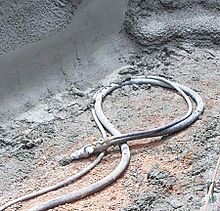Shotcrete
The concrete or mortar is formulated to be sticky and resist flowing when at rest to allow use on walls and ceilings, but exhibit sufficient shear thinning to be easily plumbable through hoses.
Shotcrete has the characteristics of high compressive strength, good durability, water tightness and frost resistance.
[3] He used the method of blowing dry material out of a hose with compressed air, injecting water at the nozzle as it was released.
F. Trubee Davison covered this and other Akeley inventions in a special issue of Natural History magazine.
Advantages of the dry mix process are that the water content can be adjusted instantaneously by the nozzle operator, allowing more effective placement in overhead and vertical applications without using accelerators.
The wet-process procedure generally produces less rebound, waste (when material falls to the floor), and dust compared to the dry-mix process.
[5] Gunite was originally a trademarked name that specifically referred to the dry-mix pneumatic cement application process.
Shotcrete is an all-inclusive term for spraying concrete or mortar with either a dry or wet mix process.
[6] By 1951, shotcrete had become the official generic name of the sprayed concrete process—whether it utilizes the wet or dry process.
It may be employed, in concert with lagging and other forms of earth anchor, to stabilize an excavation for an underground parking structure or hi-rise buildings during construction.
Development of decline pathway to go underground is critical for movement of heavy machinery, miners, and material.






